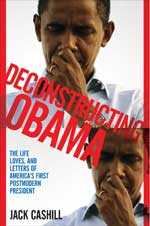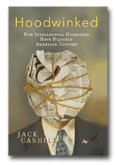How Long Before Dzhokhar Starts Palling Around with Obama?
Get your copy of Deconstructing Obama

___
Jack Cashill's book:
Hoodwinked: How Intellectual Hucksters have Hijacked American Culture

Click here for signed first edition
©Jack Cashill
AmericanThinker.com - April 21, 2013
With his capture Friday evening in Boston, terrorist bomber Dzhokhar Tsarnaev would seem to have abandoned all hope of ever amounting to anything useful. He may, however, be selling his adopted country short. In America, at least in certain quarters thereof, our fellow citizens have a history of rehabilitating terrorists and restoring them to places of honor.
President Barack Obama knows something about this. It was no more than fifteen years after Bill Ayers walked away -- "Guilty as hell. Free as a bird." -- from his 1970's career as an underground bomber that he became Obama's mentor, political adviser, and literary ghost. Ayers went on to become a distinguished professor of education at the University of Illinois and a much-sought after speaker at educational conferences around the country. Chin up, Dzhokhar!
During the 2008 election cycle, of course, the media did not want to know about any of this. Ben Smith, then of Politico, had reported as fact Obama adviser David Axelrod's claim that the Obama-Ayers relationship went no deeper than the happenstance that their children "attend the same school." True, upon learning that Obama's oldest child was born 18 years after Ayers' youngest, Smith added a comically circuitous "update," but the media shied from chasing the story or even chiding Axelrod.
At the time, however, ABC's George Stephanopoulos, as a former Clinton aide, had his own agenda. During an April 2008 presidential debate, he asked Obama about Ayers. "He was part of the Weather Underground in the 1970s," Stephanopoulos reminded the audience. "They bombed the Pentagon, the Capitol, and other buildings. He's never apologized for that." He then asked Obama, "Can you explain that relationship for the voters and explain to Democrats why it won't be a problem?"
"I know not the man," Obama replied -- no, excuse me, that was Peter on the subject of Jesus. On the subject of Ayers, Obama proved only slightly more straightforward. "This is a guy who lives in my neighborhood," said Obama for the ages. "He's not somebody who [sic] I exchange ideas from [sic] on a regular basis."
Obama then went on to scold Stephanopoulos for daring to ask a question about a man who "engaged in detestable acts forty years ago, when I was eight years old." To suggest that this relationship somehow reflected on him and his values, huffed Obama, "doesn't make much sense."
Following the debate, just about every chatterbox in the chattering class fueled what the L.A. Times called a "storm of criticism." Their rage was directed not at Ayers for his bombings or Obama for his evasiveness, but at Stephanopoulos for his effrontery. How dare he confront Obama with "such tired tripe"? demanded the Washington Post's Tom Shales. How dare he ask Obama about an "obscure sixties radical?" asked Michael Grunwald of TIME.
If Ayers was marginally in play before the debate, he was clearly out of bounds afterwards. Obama had established his distance from this guy in the neighborhood, and God help the reporter or vice presidential candidate who imagined them more closely together.
That kind of imagining was left to folks like myself in the blogosphere. Reading Ayers's 2001 memoir Fugitive Days recalled for me Ayers's active leadership of the infamous "Days of Rage." This misbegotten 1969 assault on Chicago caused significant property damage and left city attorney Richard Elrod paralyzed for life. In his honor, Ayers's pals produced a parody of Bob Dylan's "Lay Lady Lay," including the memorable lines "Lay, Elrod, lay / Lay in the street for a while / Stay, Elrod, stay / Stay in your bed for a while."
At the time, Ayers had a lower public profile than his future wife, Bernardine Dohrn, the mini-skirted guerilla hottie with her killer bod and folk-singer hair. In 1969, Dohrn attained a new level of notoriety at a Michigan "War Council." Here, she challenged her comrades to take aim on "Amerikkka" and wreak havoc within the "belly of the beast."
Dohrn then raised three fingers in a "fork salute" to the inimitable Charlie Manson, recently arrested for the murder of pregnant actress Sharon Tate and seven others. "Dig it," shrieked Dohrn. "First they killed those pigs, then they ate dinner in the same room with them, they even shoved a fork into a victim's stomach! Wild!"
At the time, however, the young woman who held Ayers's heart was the more demure -- who wasn't? -- Diana Oughton. In Fugitive Days, he speaks of her as reverentially as Al once did of Tipper. "Diana was fair with glowing cheekbones, prominent forehead, powerful arms and legs," Ayers writes. "She was somehow both elegant and simple, her golden hair and classic good looks balanced by a gaze that beamed out with unexpected intensity."
The prelude of Fugitive Days opens with Dohrn informing Ayers that Oughton and two others have been killed in the explosion of a Greenwich Village bomb factory. Oughton and her comrades had been simply and elegantly plotting to plant an anti-personnel bomb at a dance for non-coms and their dates in nearby Fort Dix, New Jersey. This is a fact to which Ayers readily owns up. The difference between him and his pals and the brothers Tsarnaev was not conscience, but competence -- advantage Tsarnaev's.
"The woman on the other end of the phone would save me soon," writes Ayers of Dohrn, "and soon after that we would plunge together into a subterranean river, the strong, swift brown god of life pulling us forward for decades to come." The man whom readers of Fugitive Days meet in this subterranean swamp is not someone they would want their president palling around with.
Ayers would claim that after Oughton was killed, he and his pals bombed only buildings, not people. Veteran cops in San Francisco take exception. Larry Grathwohl, a former FBI informant within the Weather Underground, contends that that "there are 'irrefutable and compelling reasons' to believe that Ayers and Dohrn planted the bomb that killed officer Brian McDonnell and injured nine other cops in a blast at a San Francisco police station in 1970.
As to Oughton and her two comrades who blew themselves up, Ayers wonders out loud how long it will take before America "imagines their actions as heroic."
One wonders how Obama responded to after-dinner stories chez Ayers that ended with the punch line "Kaboom"? Did he too imagine their actions as heroic? And if so, why would he think of the actions of Tamerlan and Dzhokar any differently?
Webmaster's Note: Jack Cashill's Book-TV presentation of "Deconstructing Obama" can be viewed at http://www.c-spanvideo.org/program/298382-1
Editor's note: For a more complete account of this phenomenon, read Jack Cashill's amazing book, "Hoodwinked: How Intellectual Hucksters Have Hijacked American Culture.

